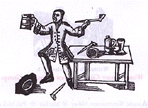
COVENT GARDEN PUBS
An Introduction to a Westminster Archives publication
london-footprints.co.uk
|
COVENT GARDEN PUBS An Introduction to a Westminster Archives publication |
london-footprints.co.uk |
Covent Garden belonged to the Abbey at Westminster until the Reformation when it was granted to the Earls of Bedford who built fine houses from the 1630s. One of the taverns established at this time was the Rose on the corner of present Russell and Catherine Streets. The reputation of this prompted Hogarth to use it for the third scene of the Rake's Progress depicting his downfall. The porter in the picture was known as Leathercoat and would lie down in the road and allow a carriage to ride over him for the price of a drink! Other notorious pubs of this time included the Fleece where Pepys writes of a Scottish knight being killed in 1660. In the Cock (where else?) three drunken knights exposed themselves and shouted obsenities as a result of which they were heavily fined.
| The growth of the fruit and vegetable market, with shops being built in the 1670s made the area less attractive and premises became coffee houses, lodging houses and brothels. The Hummums were Turkish Baths which also sold alcohol and served as brothels. The site of these is now covered by the LT Museum and Tuttons Bar (pictured). Coffee Houses which later became pubs included the Brown Bear, Will's (re-named the Bunch of Grapes) and Mile's (re-named the Marquess of Anglesey) all in Bow Street. |
|
|
Prominent in the area were the Theatre Royal (built 1633) and the Covent Garden Theatre, now the Royal Opera House (built 1732) both of which had re-builds after suffering devastating fires. Associated with the Shakespeare's Head pub was John Rich who built the Covent Garden Theatre. The pub was a victim of the fire of 1808. These connections mean a number of pubs have been named after people associated with the theatres including the present Kemble's Head (pictured). The Theatre Royal owned the adjacent Old Drury Tavern and there is a tunnel between the theatre and the present Nell of Old Drury. This pub was originally called the Lamb but was re-named Sir John Falstaff by the Victorians. The Garrick's Head was run for a time after his retirement in 1791 by William Spencer 'the celebrated Jumping Harlequin of Drury Lane'. When Edmund Kean collapsed whilst playing Othello in 1833 he was taken to the Wrekin Tavern in Broad Court, a pub often used by actors from the theatre. |
Pubs were used by various clubs and societies including the Freemasons (Apple Tree) the Beefsteak Club (Shakespeare's Head) and 'Judge & Jury' mock trials (Garrick's Head). They were also used for exhibitions including a tattooed man from the South Seas (Sir John Falstaff) a large Greenland Seal (Northumberland Arms) and what would seem to be rather racy 'Living Pictures' (Garrick's Head).
As the market grew, especially after re-building in the 1830s many premises in the area became businesses associated with the trade and pubs would be open between 5am and 9am but for market workers only. When in WWII a Canadian soldier was refused a drink he shot dead the barman of the Coach & Horses.
| The area suffered a Zeppelin raid on 13 October 1915 when 38 people were killed as groups gathered outside the pubs to watch! In WWII there were incidents of incendiary bombs including one which badly damaged the Marquess of Anglesey. The sign of this pub depicts Henry William Paget who commanded the cavalry at Waterloo where he lost a leg. |
|
The market moved out to Nine Elms in 1974 and the area was re-developed by the GLC. Some former pubs such as the Market House, Alexandra and David Garrick are now restaurants. Others have been lost to re-development including the Albion and the Harp (former Telephone Exchange - now a Nightclub) the Red Lion and the Grapes (Opera House extension) and the Shakespeare and Crown & Cushion (Drury House).
|
A long established pub, still trading under its original name is the Coach & Horses in Wellington Street which dates back to at least the 1730s. It was one of the first ordinary taverns advertising 'always something ready to eat' and is now noted for its salt beef and draught Guinness. |
Notes:
The Rake's Progress - a series of paintings by Hogarth can be
seen at the Soane Museum 13 Lincoln's Inn Fields.
Westminster Archives have bomb maps of the area with
corresponding reports and in some instances photographs. They
also have the St Martin's Scrapbook for Covent Garden with
cuttings relating to activities at the Garrick's Head.
This article was compiled from material collected as part of a project run by Westminster Archives to research and record the history of some Westminster pubs. The publication One on Every Corner covered Around Westminster Abbey - Mayfair - Pall Mall & St James - Covent Garden - North from Charing Cross - South of the Strand - Petty France & Tothill Street - The Devil's Acre with histories and notes on hundreds of Westminster pubs. It is illustrated with reproductions of maps, prints & photographs from the collections of Westminster City Archives and has indexes to pubs & licensees, useful to family historians.
ISBN 1-900893-11-8 ... 180pp ... A4 ... Wire bound ... 12.99